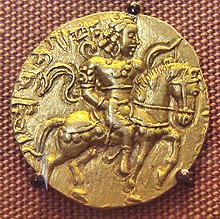Chandragupta II
Chandragupta II ruled the northern Indian Gupta empire from approx. 375–413 / 15 AD; he was nicknamed Vikramaditya ("World Conqueror"). During its long reign, India experienced a politico-military, economic and cultural heyday. Chandragupta II is considered to be a great patron of the arts, which manifests itself in numerous sculptures in architecture (see Gupta Temple ) as well as in the fine arts ( Sanchi , Sarnath, etc.). Numerous poets, including the famous Kalidasa , also worked in the vicinity of the royal court .
ancestry
Chandragupta II was the son of King Samudragupta (ruled approx. 335-375) and the grandson of Chandragupta I (ruled approx. 320-335), who is generally regarded as the founder of the Gupta dynasty. His son was Kumaragupta I (ruled approx. 415–455).
biography
In Chandragupta's biography, historical reports and fabulous narratives mix, all of which were only passed down orally for centuries before they were put down in writing at some point in the Indian Middle Ages.
After Samudragupta's death his older brother Ramagupta inherited the throne; this also seized Dhruvaswaminis , Chandragupta's fiancée. After a defeat against the Saka ruler Rudrasimha III. (r. approx. 388–395) this demanded the surrender of Dhruvaswaminis , whereupon Chandragupta decided to ride himself - disguised as a woman - to the Saka court, where he killed Rudrasimha. (According to other reports, he Rudrasimha and Sakas have defeated in a battle.) Shortly thereafter, Chandragupta then got rid of his brother also Ramagupta and married Dhruvaswamini that the mother of his son and successor Kumaragupta I was.
Another marriage with the Naga princess Kuberanaga is also recorded; Prabhavatigupta , a daughter from this connection, married Rudrasena II (ruled 380–385 or 385–390), a king of the Vakataka dynasty, who died a short time later. Prabhavatigupta took over the reign for her two underage sons, but incorporated the territory of the Vakatakas into the Gupta Empire for a period of about 20 years, which stretched from the Indus to the Ganges , i.e. H. over the whole of northern India, and extended south to the Dekkan Plateau. The most important cities at the time were Pataliputra (modern day Patna ), Prayaga (modern day Prayagraj ) and Avantika (modern day Ujjain ).
Kalidasa reports that Chandragupta, whom he only calls Vikramaditya by his nickname , defeated the Parasikas (Persians), Hunas (which means a group of the so-called Iranian Huns ) and Kambojas after his victory over the Sakas in several campaigns in northwestern India . The names of other subjugated peoples at the foot of the Himalayas are also mentioned: Mlecchas , Yavanas and Tusharas .
Gupta Empire

Religion
After centuries of religious, philosophical and intellectual dominance of Buddhism in northern India, the Gupta rulers, above all Chandragupta II, were followers of Hinduism , especially Vishnuism . Chandragupta II. As donor, several cave temples in Udayagiri and the earliest (preserved) free-standing temples in India are attributed. Nevertheless, he was also active as a donor of Buddhist temples ( Sanchi ) and sculptures ( Sarnath ).
Iron Pillar
The famous iron pillar in the Qutub Minar complex in Delhi is said to have been erected in Udayagiri. An inscription attached to the column bears the name Chandra , who is referred to as the admirer of Vishnu and is therefore equated by some researchers with Chandragupta II.
Other
The Chinese pilgrim Faxian visited Pataliputra around the year 400 and reports: "The people are rich and happy, free from any poll tax or government restrictions. Only those who cultivate the king's land pay a land tax. They are free to go or The king rules the country without applying the death penalty. Even high traitors only have their right hand cut off. " He also narrates that the population does not eat meat, nor onions and garlic; Wine is also unknown.
Coin minting
In the great empire of the Guptas under Chandragupta II, the economy and trade flourished. A large number of gold and silver coins were minted, the minting quality of which far exceeded all known coinage of the time.
literature
- Hermann Kulke , Dietmar Rothermund : History of India. From the Indus culture to today. 2nd, updated edition of the special edition. CH Beck, Munich 2010, ISBN 978-3-406-60414-0 .
- Fred Virkus: Political structures in the Gupta empire . (300–550 AD) (= Asia and Africa Studies at the Humboldt University in Berlin. 18) Harrassowitz, Wiesbaden 2004, ISBN 3-447-05080-2 .
Web links
- Chandragupta II., History - Info (English)
- Coins from Chandraguptas II. - Photos + information (English)
| personal data | |
|---|---|
| SURNAME | Chandragupta II |
| ALTERNATIVE NAMES | Vikramaditya |
| BRIEF DESCRIPTION | Ruler of the north Indian empire of the Gupta (375–415) |
| DATE OF BIRTH | 4th century |
| DATE OF DEATH | at 413 |
